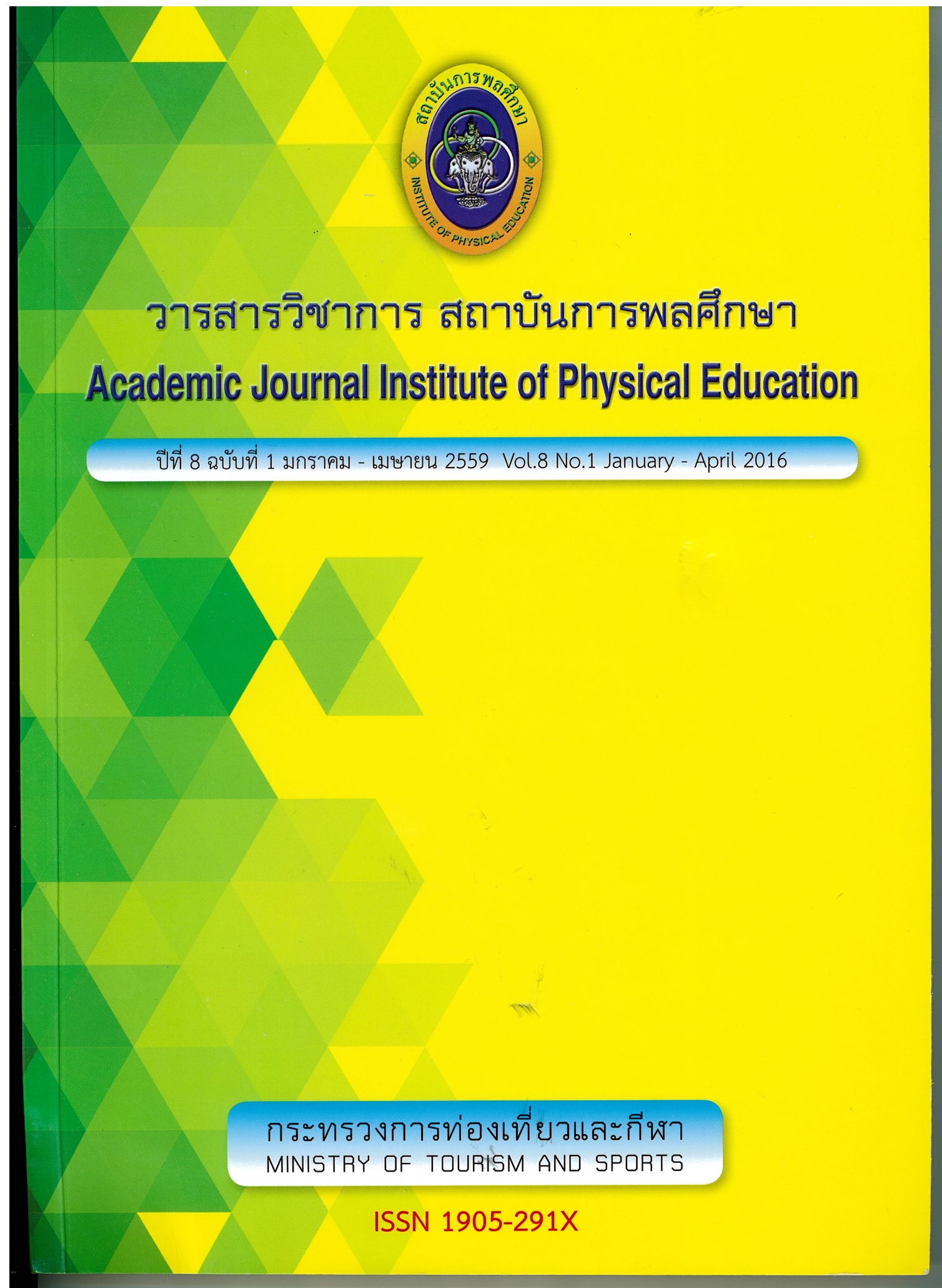A Development of Water Polo Skills Test For Youth Level
Main Article Content
Abstract
The purpose of this research was to construct water polo skills test for youth athletes. The test consisted of four items: 1) dribbling, 2) vertical jumping, 3) shooting, and 4) throwing. The face validity of tests was agreed on by 9 experts. The test-retest method was used to determine the reliability with a sample of 20 youth water polo athletes in seven-day interval and the objectivity was tested by the scoring judgment of two testers. The subjects were 71 youth water polo athletes for the construction of the criterion. The data were analyzed by using mean, standard deviation and Pearson product-moment correlation coefficient. The results on construction of water polo skills tests for youth Athletes for dribbling, vertical jumping, shooting, and throwing, were the following: Index of Item Objective Congruence were 0.87 0.85 0.85 and 0.84, reliability were 0.98 0.99 0.80 and 0.84, content validity were 0.99 1.00 1.00 and 1.00 respectively. It indicated that the water polo skills tests possessed a satisfactory quality for application to youth athletes.
Article Details

This work is licensed under a Creative Commons Attribution-NonCommercial-NoDerivatives 4.0 International License.
The published article is a copyright of the Academic Journal of Thailand National Sports University. The passage appeared in each article in this academic journal is a perspective of each author which is not related to the journal. Each author is required to be responsible for all components of his/her own article. If there are any mistakes, each author must be responsible for those mistakes on his/her own.
References
การกีฬาแห่งประเทศไทย (2543), ประวัติกีฬาโปโลน้ํา, กรุงเทพมหานคร: การกีฬาแห่งประเทศไทย (จุลสาร),
คณิต กิตติโกวิท (2545). กฎ กติกาการแข่งขันโปโลน้ํา, กรุงเทพมหานคร: โรงพิมพ์ชนารักษ์,
พระราชบัญญัติการศึกษาแห่งชาติ (ฉบับที่ 2) จรินทร์ ธานีรัตน์. (2519), การทดสอบและการวัดผลทางพลศึกษา, กรุงเทพมหานคร: สํานักพิมพ์โอเดียนสโตร์,
เจษฎา ตาลเพชร. (2544). การสร้างแบบทดสอบทักษะกีฬาบาสเกตบอลสําหรับนักเรียนชั้นมัธยมศึกษาปีที่ 3 โรงเรียนขยายโอกาสทางการศึกษาในจังหวัดสุพรรณบุรี, วิทยานิพนธ์ศิลปศาสตร์มหาบัณฑิต สาขาวิชาพลศึกษา มหาวิทยาลัยเกษตรศาสตร์.
เฉลิมชัย สินธุอารีย์. (2545). การสร้างแบบทดสอบทักษะกีฬารักบี้ฟุตบอลสําหรับนักเรียนชายระดับมัธยมศึกษาตอนปลาย โรงเรียน ภ.ป.ร.ราชวิทยาลัย วิทยานิพนธ์ศิลปศาสตร์มหาบัณฑิต สาขาวิชาพลศึกษา มหาวิทยาลัยเกษตรศาสตร์,
ชาตรี จันทร์ดุสิตขจร. (2539) การสร้างแบบทดสอบทักษะกีฬาแฮนด์บอลสําหรับนักเรียนระดับมัธยมศึกษาตอนปลายในกรุงเทพมหานคร. วิทยานิพนธ์ศิลปศาสตร์มหาบัณฑิต สาขาวิชาพลศึกษา มหาวิทยาลัยเกษตรศาสตร์.
ทิวา จินตกานนท์. (2547). การสร้างแบบทดสอบทักษะกีฬาฮอกกี้เชิงปริมาณและคุณภาพสําหรับนิสิตระดับอุดมศึกษา วิทยานิพนธ์ศิลปศาสตร์มหาบัณฑิต สาขาวิชาพลศึกษา มหาวิทยาลัยเกษตรศาสตร์.
ธวัช วีระศิริวัฒน์. (2538), หลักและการฝึกกีฬา, กรุงเทพมหานคร: สํานักพิมพ์โอเดียนสโตร์.
บุญชม ศรีสะอาด. (2545). การวิจัยเบื้องต้น. (พิมพ์ครั้งที่ 7). กรุงเทพมหานคร: สุรีวิริยาสาสน์.
บุญส่ง โกสะ (2547), การวัดและประเมินผลทางพลศึกษา, กรุงเทพมหานคร: สํานักส่งเสริมและฝึกอบรมมหาวิทยาลัยเกษตรศาสตร์ วิทยาเขตบางเขน.
ผานิต บิลมาศ (2530), การทดสอบและการประเมินผลทางพลศึกษา, ภาควิชาพลศึกษา คณะพลศึกษา มหาวิทยาลัยศรีนครินทรวิโรฒ ประสานมิตร.
พินิจ ประหยัดทรัพย์. (2527), การสร้างแบบทดสอบทักษะกีฬาฟุตบอลสําหรับนักศึกษาระดับอุดมศึกษา. วิทยานิพนธ์ศิลปศาสตร์มหาบัณฑิต สาขาวิชาพลศึกษา มหาวิทยาลัยเกษตรศาสตร์,
พูนศักดิ์ ประถมบุตร. (2532), การทดสอบและการประเมินผลพลศึกษา. กรุงเทพมหานคร: โอ เอส พริ้นติ้ง เฮ้าส์.
วิธูร อักษรพันธ์. (2544). การสร้างแบบทดสอบทักษะกีฬาโปโลน้ําและเกณฑ์ปกติของแบบทดสอบสําหรับนักกีฬาโปโลน้ําในระดับอุดมศึกษา วิทยานิพนธ์ศิลปศาสตรมหาบัณฑิตสาขาพลศึกษา มหาวิทยาลัยขอนแก่น.
วรศักดิ์ เพียรชอบ. (2523), หลักและวิธีการสอนพลศึกษา, กรุงเทพมหานคร: ไทยวัฒนาพานิช.
สืบสาย บุญวีรบุตร. (2541), จิตวิทยาการกีฬา, ชลบุรี: ชลบุรีการพิมพ์.
Aziz, A.R., Lee, H.C. , and The, K.C (2002). Physiological characteristics of Singapore National Water Polo Team Players.
Barrow, H.M. and R. McGee. (1979). A Practical Approach of Measurement in Physical Education. Philadelphia: Lea and Febiger.
Baumgartner, T.A. and A.S. Jackson. (1991). Measurement to Evaluation in Physical Education and Exercise Science. Lowa: Wm.c. Brown Publishers.
Hastad, D.N. and A.C. Lacy. (1998). Measurement for Evaluation in Physical Education and Science. Boston: Allyn and Bacon.
Kirkendall. D.R., J.J. Gruber and R.E. Johnson. (1980). Measurement and Evaluation for Physical Education. Dubuque, lowa: Wm.c. Brown Publishers.
Kudson, D.V. and C.S. Morrison. (1997). Qualitative Analysis of Human Movement. Illinois: Human Kinetics.
Methews, D.K. (1978). Measurement of Physical Education. Philadelphia: W.B. Suanders Company.
Meyers. C. R. and E.T. Blesh. (1962). Measurement in Physical Education. New York: The Ronald Press Company.
Morrow, J.R., A.W. Jackson, J.G. Disch and D.P. Mood. (2000). Measurement and Evaluation in Human Performance. Illinois: Human Kinetics.
Safrit, M.J. (1990). Introduction to Measurement in Physical Education and Exercise Science. St. Louis: Times Mirror/ Mosby College Publishing.
Strand, B.N. and R. Willson. (1993). Assessing sport skill. Champaign, Illinois: Human Kinetics Publishers.
Tritschler, K. (2000). Practical Measurement and Assessment. New York: Lippincott Williams and Wilkins.
Willgoose, C.E. (1961). Evaluation in Health Education and Physical Education. New York: McGraw-Hill Book Company.
Kirkendall. D.R., J.J. Gruber and R.E. Johnson. (1980). Measurement and Evaluation for Physical Educators. Dubuque, lowa: Wm.C. Brown Publishers.


